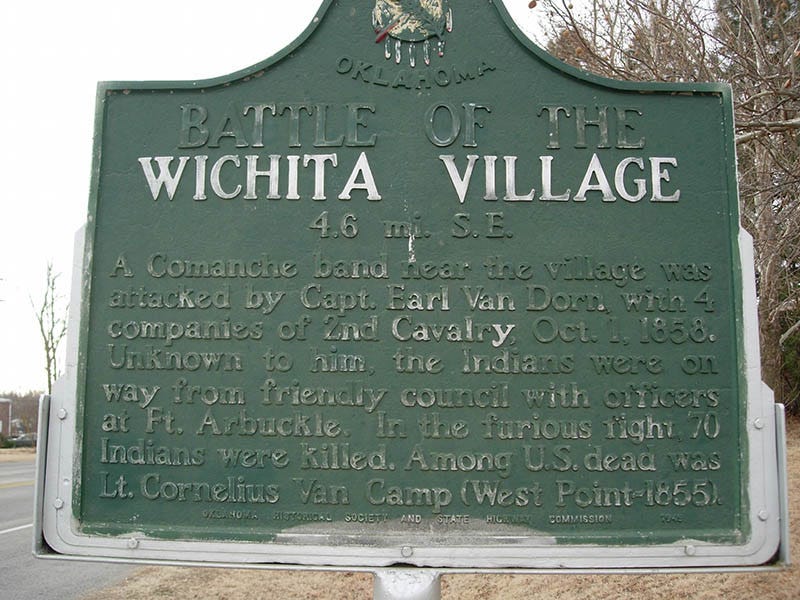Watermelon Seed Spitting Contest This Saturday!
An Oklahoma tradition
The 2020 census puts Rush Springs, Oklahoma, population at a dwindling 951. This weekend, about 30,000 people will come out of the woodwork from near and far to join them for the town’s 74th annual Watermelon Festival. Rush Springs is known as the watermelon capital of the world, a bit of hyperbole that there is no reason to dispute because, if anything, the festival is the embodiment of a venerable American summer pastime where the local harvest and the town’s history is spiritedly celebrated. Boy Scouts fry up freshly caught catfish and a Rush Springs’ lawyer barbecues pork ribs. One very ornery woman brews root beer and is proficient in giving inquisitors a professional-grade stink eye if asked about her recipe. Townspeople and nearby farm families put on a rousing rodeo and sell crafts such as handmade pony-hide handbags and Indian war bonnets. The amusement rides are fit only for kids ten years and younger and, come twilight, musicians on a tiny stage near the center of the fairground have a playlist that goes from audience participating two-steps to slow, very slow, late night swaying.
Rush Springs’ history is, indeed, centered on a natural spring around which Wichita Indians settled and cattle drivers along the Chisholm Trail stopped to water their herds. Like all of Oklahoma before it was a state, the area was Indian territory with somewhat amiable relations between the tribes and the U.S. Army. That was until a grossly misinformed captain nearly wiped out a nearby Comanche settlement. During the Civil War, the territory’s slave owning Five Civilized Tribes made a devil’s bargain to fight for the Confederacy, but the Rush Springs’ Wichita tribe stayed neutral. They didn’t get anything for it but then they didn’t lose any of their men the way the other tribes did.
11% of the population is still Indian and the spring now bubbles up through a couple of pipes in Jeff Davis Park (yes, that Jeff Davis). Many festival goers crowd around it for a drink. Some may be deterred by noting that the old Rush Springs Cemetery sits on the hill directly above the pipes but the county health department says the water is free of bacteria. Certain gastroenterologist, let’s say from Brooklyn, beg to differ. Still, the water is cold and refreshingly sweet tasting on a steel-furnace-melting kind of a day and there’s a course of treatment for any eventual parasite-inducing aftereffects of a sip or two.

All of this is fine and good but there’s one small town pleasure that seems to draw everyone to the festival and that is the watermelon seed spitting contest. Seed spitting is a wonderous sport to behold. The MC explains the rules: players stand behind the line at the edge of the stage; the seeds must land inside the designated fairway which includes off the backside of stage if the judges can find it; and the judges’ decisions are final. In case of a tie, a spit-off will be held.
Touching, crossing, or letting your false teeth fly out are grounds for automatic disqualification. ~ Rush Springs’ watermelon spitting MC
First up is the Watermelon Queen, a pretty teenage girl dressed in the official watermelon-printed full-skirted halter dress. She shows admirable technique by throwing her head way back then snapping it forward for a good 35 foot landing, a record that lasts through several rounds of cocky teenage boys. The crowd really gets into it with baseball game-worthy enthusiastic whooping.
Rush Springs Watermelon Seed Spitting Contest is a serious stop on the campaign trail. Because it’s an election year the final rounds show off the skills of state and local incumbents and their hopeful (Democrat) challengers. A rumor about the governor showing up meanders through the audience but it’s his campaign manager who stands behind the line and shoots off a measly 22 feet. It’s a mark of good-old fashioned, now rare, decency that the politicians cheer one another along even with some backslap joshing when one party best the other. After the trophy is awarded to a gangly 15-year-old boy—the runner up being an 8-year-old girl—the politicians stick around and spend a considerable amount of time talking to anyone who comes up to them. It’s heartening—no cross words, no signs of possible fisticuffs. Just everyone enjoying a silly event on an August afternoon.
And so it goes as people wander up to the pavilion for a heavy quarter slice of watermelon. The custom is to lug it to one of the rows of rough plank high tables and devour it in a concentrated, chin-dripping fashion. Rush Springs watermelons are not like what might be available in other localities. The flesh is dense, meaty, succulent, bracingly sweet. Fellow watermelon eaters sprinkle the flesh with salt, perhaps a habit that out-of-towners need to cultivate before appreciating. But it doesn’t matter, for the real distinguishing mark of a Rush Springs’ watermelon is the prodigious amount of seeds that pull you back to your childhood and underscore how sorely you’ve missed seeds in the pale varieties available at home.
All down the long tables people are joyfully making a mess of themselves. Nearly everyone finishes their huge slices right down to the rind. Paper napkins really don’t take care of sticky hands and faces but people walk away as sated as the fat bees that circle lazily above the piles of demolished watermelon hulls.




I so often lament the seedless watermelons available at the grocery. Have we really become so lazy that we can’t even extricate some seeds to enjoy one of summer’s most iconic, refreshing treats? And also, how on earth can one even expect to challenge a worthy opponent to a watermelon seed spitting contest with those anemic, flabby wanna-be-not-even-seeds? Rush Springs may need to go on the travel destination list for next year!
You'll love he